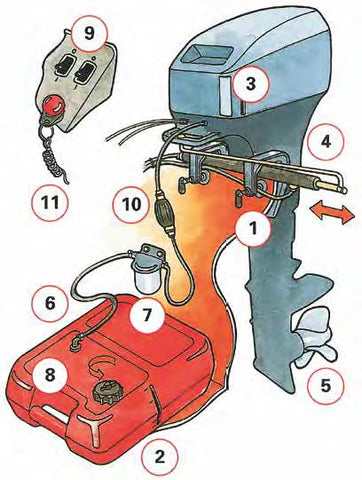Your Essential Outboard Engine Checklist
Pre-start checks
1. Clamps or Bolts
Start by checking that the engine is securely clamped or bolted to the boat.
2. Fuel Check
Ensure that your fuel is free from impurities and has not expired. Make sure you have an adequate amount for your journey, along with a small surplus. Avoid excessive filling.
3. Oil Check
Certain two-stroke outboard engines need to blend fuel with oil. It is important that you use marine oil specifically designed for two-stroke engines (known as TCW3). Make sure they are mixed in the appropriate ratio.
Other two-stroke engines possess independent oil storage. They also necessitate the use of appropriate marine two-stroke oil.
Four-stroke outboard motors possess an internal reservoir similar to an automobile engine. Use the dipstick to verify the oil level, and if required, replenish it with engine oil (not two-stroke oil).
4. Controls Check
To check if the controls work properly, turn the steering wheel all the way left and right. Also, move the throttle/gear control forward and backward.
5. Propeller Check
Ensure that the propeller and drive leg are clear of obstructions like rope, seaweed, fishing line, and plastic bags.
6. Fuel Line
Check that the fuel line is attached to both the tank and the engine. Ensure it is in optimal condition and devoid of any bends.
7. Fuel Filter
Please inspect the filter bowl for any water or dirt. If necessary you should empty the bowl. However, make sure there is a water separator/filter present.
8. Integral Tanks
Make sure to turn on the fuel valve for small engines with built-in tanks.
9. Tank Vent
Make certain the tank vent is open.
10. Battery Switch
If you connected your engine to the boat's electrical system, remember to turn on all the required switches and circuit breakers.
10. Primer Bulb
If it's fitted, the primer bulb should be squeezed until it becomes firm.
11. Kill Cord
Connect the kill cord to the kill switch and attach the other end to your leg or lifejacket for safety. Then you should test to see that it works.
After starting
1. Cooling Water
Check right away that the cooling water* tell-tale has a proper water flow. Inspect if the tell-tale hole is blocked if it doesn't.
2. Warm Up
Ensure the engine is sufficiently heated before starting to ensure a smooth idle before driving.
Smaller marine engines cool themselves by circulating air instead of water, so this point does not apply to them.
Image source: https://rnli.org/SiteCollectionDocuments/Outboard-engine-checklist.pdf


